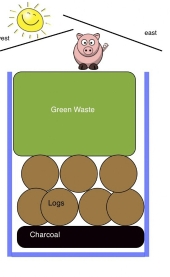posted 12 years ago
My attempts at hugelkultur are some of the crudest you are likely to see. They are large, conical slash piles with soil mixed in and a dollop of dirt placed on top. All were produced using an excavator. I have a few acres that will eventually be cleared, but for now the land is covered in cottonwood and alder that grows at an amazing rate. My chainsaw prevents the succession to conifers that would naturally occur. I thin it and add the debris to the piles. This along with a 1 km driveway skirted with hardwoods means that this is a natural material for me to use. Neighbors with more road and property than me are happy to let me thin out these fast growing trees that quickly take over roadways.
NOW THE CHICKENS ---- The largest of my piles is about 900 sq ft on the base and 14 ft tall. With a little bit of flattening on top, this would make an excellent spot for a small coop of 50 -100 sq ft. The woody material makes a perfect sponge for the nutrients inherent in chicken manure, feathers and wasted food. I imagine the coop as a simple 4 sided wire enclosure with some perches and a roof and no floor. They would have free access to this and other coops in the shade of the forest north of the beds. 80F is a hot day on Vancouver Island and we never get really cold. Chickens would use these coops most of the time.
By producing small coops on top of several beds, it would be possible to completely avoid the task of dealing with manure. The coops would be used on a rotational basis in order to allow time for the worms and other critters to consume their waste and incorporate it into the soil. Nutrient leaching would be virtually eliminated since the richest manure on the farm is deposited on top of several feet of nutrient poor sponge. If I decide to water the beds, it could be done from the top so that manure juice would wash to the lower layers. I dug into the top of the large bed recently and it was much drier than soil 6 feet lower. Still there were plenty of bugs. I'll bet that when the gate to a coop is opened after several weeks of closure, the chickens would race back in to gobble up those bugs.
KEY HOLE HUGELKULTUR ------ The concentration of nutrient in this system is similar to that of key hole gardens. With a standard key hole, there is a good chance that rodents will take up residence. Chickens eat rodents. All sorts of scraps could be fed to the chickens in their coop. They'll either eat it or they won't. Anything that they don't eat will be trampled and covered in chicken shit. Wood chips or leaves could be added whenever a soggy mess develops. Switch to the next coop on the next bed whenever it seems to be getting messy.
FENCING ---- My beds must be fenced or deer will eat everything, so it's just a matter of creating a corridor up the north side of each bed leading up to the coop.
MOVABLE ROOF ----- A lightly framed roof of this size with a canvas covering could weigh as little as 20 lb. One roof could serve several wire enclosures of the same size. Coops that are in fallow mode could absorb sun and rain. Quick growing cover crops would have a few weeks to grow before being consumed by the chickens on the next rotation. Alternatively, each coop could have a roof framework and only the canvas would be moved to another bed.
ALTERNATIVE SHADE and don't bother with a roof.---- During the growing season, heavy rain is rare. Vining crops such as melons, beans and peas could grow over the wire walls and roof. For this to work the crops might need to be suspended from a secondary trellis with a suitable space around the enclosure to prevent the chickens from destroying the crop and to allow easy harvest of dangling fruit. The chickens would use these structures at night and when eating. Since they can leave to seek alternative shelter, these coops can be very rudimentary.
OTHER CRITTERS ------ Ducks, geese, guinea fowl and goats could use various versions of this concept. Goats will naturally seek high spots with a great view. They could browse over a wide area and deposit poop while resting on their "hills". If water were supplied, they would visit more often. Fencing would need to be well built since goats would love to rip every living thing from a lush hugel bed.
Pigs could dig their way into the crop area in a matter of minutes and would never be contained by a bottomless pen with such soft ground beneath no matter how strong the above ground structures may be.
I'LL FINISH THIS LATER, COMPLETE WITH PHOTOS AND DRAWINGS.






